#tending news in india
Explore tagged Tumblr posts
Note
Whenever someone says "This would kill a Victorian child." Or "This would kill a medieval peasant." I have to think about Machete. Would he... would he survive eating a Dorito?
.
#I've never had doritos myself so I have no point of reference#I think they sell them here nowadays but it's a fairly new thing and I don't eat a lot of chips#they had spices in the past but they were extremely expensive#I think most of them had to be imported from South/Southeast Asia#India in particular#few could afford such luxury goods but if you could serve people spicy food it was a mark of wealth#so historically a lot of upper class dishes were extra flavorful#potentially to an overpowering degree maybe#it was a status thing#a dorito wouldn't kill him but I've mentioned he secretly tends to favor somewhat bland and unthreatening foods#that won't set off his sensory issues#he'll eat the various nutmeg cinnamon clove saffron ginger creations people serve to him because declining would be a massive faux pas#but it's not an enjoyable experience#answered#anonymous#give him some light broth and a little bit underseasoned chicken to eat with his watered down wine
245 notes
·
View notes
Text
Different variety of paan franchise | New variants tend
Be it the chocolate paan, butterscotch paan, or mango paan, these new variants tend to fascinate a younger as well as an older audience.
#best paan franchises model in india#banarasi paan cafe franchise#paan variety in india#paan franchise opportunities in india#best banarasi paan franchise#New variants tend
0 notes
Text
Astro obs part 9
🐌 The planets in your 12th house indicate your sleeping style:
Sun in 12th house - their sleep schedule is extremely messed up; for them, daylight hours = nighttime hours and vice versa, so they have trouble being themselves during the day; their true self comes out at night
Moon in 12th house - goes to sleep very late; full moons have a special effect on these people; their intuition is more clear at night; as kids, they probably slept a lot with their mother
Mercury in 12th house - loves texting/calling people late at night; they might journal their thoughts before sleep because they overthink a lot and it helps to clear their mind or maybe they just like to relax by reading a book at night
Venus in 12th house - cares a lot about getting their "beauty sleep"; sleeps with sleep masks on, buys expensive bed lingerie, skincare night routine might be very important; loves sleeping in general lmao
Mars in 12th house - enjoys working out before going to sleep, can go to sleep angry because they tend to get into conflict more at night than during the day
I have Uranus in 12th house and i can be both a light sleeper or a heavy sleeper, depending on where i am. For example, when i'm traveling, during the first night i wake up several times, but from the second night on i sleep like a baby lmao. Another thing would be that i can't sleep in a quiet car but i don't have any problem sleeping during a thunderstorm
🐌 Mars in fire signs (Aries, Leo, Sag) and Mars in 3rd house individuals love riding motorbikess
🐌 While Mars in 9th house peeps would probably love to go on a world tour on their motorbike. The sign ruling their 9th house represents the countries they would love to visit (i'm aware that some of these can only be visited by plane, take it with a grain of salt):
♈ in 9th house: Ireland, Poland, Japan, Zimbabwe
♉ in 9th house: Cuba, Paraguay, South Africa, East Timor
♊ in 9th house: Denmark, Norway, Sweden, Iceland, Montenegro
♋ in 9th house: Canada, USA, Bahamas, Argentina, Slovenia, Madagascar
♌ in 9th house: Hawaii, France, Italy, The Netherlands, India, South Korea, Peru, Bolivia
♍ in 9th house: Switzerland, Mexico, Brazil, Chile, Vietnam
♎ in 9th house: Belgium, Portugal, China, Equatorial Guinea, Lesotho
♏ in 9th house: Panama, Spain, Turkey, Arab countries (Saudi Arabia, UAE), Palestine, Lebanon
♐ in 9th house: Finland, Lithuania, Romania, Tanzania, Thailand
♑ in 9th house: UK, Germany, Czech Republic, Australia, Camerun
♒ in 9th house: Greece, New Zealand, Philippines, Singapore, Sri Lanka
♓ in 9th house: Morocco, Tunisia, Egypt, Mauritius, Saint Lucia

🐌 I have a feeling Pisces Suns like to spend their time in a garage lmao. Mostly because their opposing sign, Virgo, would hate to spend time in a garage due to how dirty it can get.
🐌As a 7th house Sun who's been in love for almost a year now (haha, are we surprised, ofcours not; i'm not even in a relationship with him but ugh we're so perfect for each other), i realised that Sun in 7th house people tend to behave differently with their partner when they're in a healthy relationship vs when they're in a toxic one
Sun in 7th house in:
♈ Aries in a healthy relationship: empowers their partner, knows how to balance me time vs us time in a healthy manner, encourages their partner to take safe risks
♈ Aries in an unhealthy relationship: impulsive, impatient, selfish, dismisses their partner's feelings, often controlled by rage, prone to abusing their partner
♉ Taurus in a healthy relationship: veryyy generous (their love language is gift giving), accommodating to their partner's wants and needs, cooks for their partner
♉ Taurus in an unhealthy relationship: stubborn af, hard to please, focused more on the material gain from their partner rather than the love they share
♊ Gemini in a healthy relationship: curious, always lightens the mood of their partner by cracking up tons of jokes or telling them funny stories, knows that communication is key to everything so they're not afraid to discuss serious topics, teaches their partner a lot of random stuff
♊ Gemini in an unhealthy relationship: superficial, doesn't have a problem moving on from their partner to another person in a matter of seconds, if they're still in school/college, then they prioritize studying over their partner
♋ Cancer in a healthy relationship: nurturing, knows how to balance babying their partner vs being babied by their partner, emotionally vulnerable, feels safe enough to present their partner to their family early on in the relationship
♋ Cancer in a unhealthy relationship: if they don't trust their partner, they tend to become emotionally closed off to hide their deep sadness; defensive, but if their partner attackes them, then they'll hide, worries excessively, avoids presenting their partner to their family
♌ Leo in a healthy relationship: treats their partner like the king/queen they are, keeps their ego in check so it doesn't interfere with the relationship, if they've got artistic talents (music, acting, art etc.), they'll show their love for their partner by performing in front of them
♌ Leo in an unhealthy relationship: egocentric, shows off their partner/relationship too much out of pride, often feels entitled in the relationship and wants to be put on a pedestal by their partner
♍ Virgo in a healthy relationship: selfless to a healthy degree, remembers every lil detail from every casual conversations with their partner just to please them, remembers every important date and plans ahead for it, takes care of their partner when they're sick
♍ Virgo in a unhealthy relationship: critical, overfixates on past hurts and mistakes that their partner made in the relationship (often times their partner doesn't even remember those things because they're usually not that serious), loves their pets more than their partner
♎ Libra in a healthy relationship: romantic, charismatic, truly values their partner and the relationship with them, acts fair in the relationship, teaches their partner lovingly about the importance of honesty, truth and a healthy give and take dynamic in a relationship
♎ Libra in an unhealthy relationship: doesn't prioritize the relationship; instead, they flirt with others despite being in a relationship, emotionally detached, cold and calculated in their current relationship
♏ Scorpio in a healthy relationship: loyal, loves their partner deeply and intensely, but without suffocating them, keeps their partner's secrets like they're a locked safe box with no public access
♏ Scorpio in an unhealthy relationship: obsessive, manipulative, seeks to dominate their partner, displays stalkish behaviour in the relationship, liar
♐ Sagittarius in a healthy relationship: exposes their partner to various cultures, belief systems and philosophies to expand their mind and form their own opinion on certain topics, loves freely but is still able to maintain a long-term relationship, improves their partner's mood, usually brings an element of surprise and excitement to the relationship
♐ Sagittarius in an unhealthy relationship: travels in order to avoid dealing with their partner, parties a bit too much, doesn't take the relationship seriously
♑ Capricorn in a healthy relationship: loves their partner in a mature, serious and secure manner, doesn't shy away from improving their partner's social status and/or career if they can, discusses plans for the future (getting married, having kids, adopting pets, buying a house) with their partner early on in the relationship, they make time for their partner, despite the fact that they're busy most of the time
♑ Capricorn in an unhealthy relationship: displays no emotions or physical affection in the relationship, has a hard time communicating their thoughts with their partner, settles in a relationship for the wrong reasons (money/kids/safety/"i'm getting old and i need to have my life established"), prioritizes work/career over their partner
♒ Aquarius in a healthy relationship: flexible, makes their partner's dreams and aspirations come true (whether they're related to the relationship or not), has got a very open-minded attitude towards their partner's opinions, lifestyle and identity, takes the time to become friends firsts with their future partner because they value a relationship built on solid foundation (often times their partner is also their best friend), knows how to balance couple time vs time with friends
♒ Aquarius in an unhealthy relationship: displays wishy-washy behaviour, emotionally detached, prioritizes their friends over their partner, seeks online validation from strangers and acquaintances to fulfill their needs
♓ Pisces in a healthy relationship: sensitive to their partner's emotions, knows how to balance wearing their heart on their sleeve vs hiding their emotions in unfavourable circumstances, always honest with their partner
♓ Pisces in an unhealthy relationship: prone to drown their relationship problems and sorrows in alcohol, drugs and meds for mental health issues, runs away from problems instead of dealing with them with their partner, displays dishonesty to a fault, prone to self-sabotage
#astro#astro community#astro placements#astrology#astro observations#astro posts#astro notes#astro blog#astroblr#astrology notes#astrology observations#natal chart#sun in 7th house#sun in 12th#12th house#mars in 3rd house#mars in 9th house
1K notes
·
View notes
Text
Astro Notes

A lot of Earth Bella Asteroid placements (specifically Virgo & Taurus) are it girls! Most of them don't even realize it becuz they think they're "plain". However, their beauty lies in their natural & effortless beauty! (Rihanna, Marsai Martin, Reagan Gomez-Preston, India Love)
Chiron in Synastry can heal or ruin
2H stelliums tend to be big on body care and love anything that makes them smell good. esp suns & venus. These are usually the ppl who are always getting told how good they smell and what they use.
Ppl with 2H ruler in the 1H can literally do anything to make money & it'll work so look towards the sign for more insight. 2H ruler in the 1H with the 2H in sag, teaching related to self in some way. For ex, teaching astro and using ur placements and ur chart as an example
4H NN focus on building a community. take pride in asking for help and knowing u have ppl to fall back on. go to family gatherings and build relationships (whether ur own fam or friends/partners fam).
In Moon-pluto & venus-pluto synastry, the planet person craves the pluto person and is usually extremely devastated when the relationship/friendship ends & it changes them in a drastic way whether for better or worse.
2H stelliums, 2H suns & chart rulers in the 2H... ppl are always trying to find out how you make money, how much money you make & what u spend ur money on. Ppl with these placements get called "big money" often or notice that other ppl are always offering up ur money.
11H Juno's spouse NEEDS to be their bestfriend. If they don't feel like they can talk to them about anything, do everything & more with this person it'll fail.
When u start to crave what ur NN rules over, know you're going in the right direction. 4H NN-when they crave having a family/community. Pisces nn, going with the flow and letting go of control
8H transits make you realize ur fears, trauma & wounds more often. You become more vulnerable as well as doing more things related to ur 8H sign. 8H Gemini-speaking about ur insecurities and vulnerability which is something u usually don't do. This is also a great time to get rid of bad habits, budget, save, isolate to rebirth, & and come out as a new person.
I do all readings & accept payements thru cashapp, apple pay, zelle & paypal! Dm me to book
#12th house#astro notes#astro observations#astro community#birth chart#astrologer#synastry#ebook#astrology#profection years
476 notes
·
View notes
Text
When Lieutenant-General Robert Baden-Powell launched the Boy Scout movement in 1908, he needed a hero his boys would respect. [...]
Civilization sapped a man's strength: as Baden-Powell put it some years later, 'with its town life, buses, hot-and-cold water laid on, everything done for you,' it tended 'to make men soft and feckless ... God made men to be men. The middle class had to lead the way, and take a lesson from the Empire. The colonists risking their lives in Canada, Australia, New Zealand, or Africa had strength and initiative; in contrast to the bored or indifferent or pleasure-seeking islanders, they were real men. [...]
The frontier myth supported the frontiersman as a cult figure, it used 'primitive' races such as the 'Red' Indian and the Zulu as examples of martial virility, and, in Baden-Powell at Mafeking, it made the imperial scout a national hero. The outward symbols of the frontiersman - his cowboy hat, his flannel shirt and neckerchief, and perhaps most oddly, his short trousers (as used by Baden-Powell in India and on the South African veld) - dramatized through the Boy Scout movement the call to a revitalized manhood. [...]
The social ideas that informed and inspired the youth movements can be simplified, but they were by no means simple; Scouting cannot be understood without some summary of its historical background. Both it and the other youth movements reflected and were a response to several quite different influences: popular imperialism, social Darwinism, the crisis of masculinity and the search for 'national efficiency,' social concerns about poverty and slum conditions, new theories of education, and the value of fresh air. [...]
For Baden-Powell, the Matabele campaign [a region in what is now known as Zimbabwe] was a succession of hot days and cool nights on the high veld, scouting the Ndebele, tracking their spoor, spying on their positions, escaping their ambushes, killing them in their caves.
In the Matopos hills Baden-Powell learned the necessity of studying his enemy, using the landscape, and the importance of camouflage. Scouting was thus a science, no longer an inbred sense peculiar to the native. [...] Baden-Powell discovered that though the Ndebele were clever in many little ways, they rarely took the trouble to cover their own spoor, and they were useless in the dark. The civilized scout could answer intuition with logic, and meet nature with science.
[Sons of the Empire, The Frontier and the Boy Scout Movement, 1890-1918. Robert H. MacDonald]
While girls wanted to join the Scouts, Baden-Powell rejected this idea, fearing girls’ femininizing influence on boys and that girls would turn into tomboys. He instead advocated for the development of a separate organization, the Girl Guides, to provide girls with distinctive training that centered around their future roles as wives and mothers. [Elizabeth Dillenburg]
[Girl Scouts USA was founded by] Juliette Gordon Low in 1912, a year after she had met Robert Baden-Powell [...] Low was the granddaughter of Juliette Magill Kinzie and John Harris Kinzie, and her maternal grandparents were one of the earliest settlers of Chicago. Juliette Kinzie wrote about her experiences in the Northwest Territory (now the state of Wisconsin) in her book Wau-Bun: The Early Day. Low incorporated some of her grandmother's experiences on the frontier into the traditions of Girl Scouts. [Wikipedia]
Militarism, racist pedagogy, and colonialist violence, some of the strongest threads that wove together Baden-Powell’s two lives, were also at the heart of the genocidal education projects developed by settler states during the nineteenth and twentieth centuries. In Canada, these included the federally funded and church-run Indian Residential Schools, where Scout and Guide groups were thought to provide Indigenous students with an important training in appropriate gender roles and physical discipline.[...] While in Toronto, Baden-Powell also gave an invited speech at the Imperial Education Conference, where he proudly claimed that the Guides and Scouts had been “found particularly useful in the schools for Red Indian children, just as [they] had also proved useful in a like manner on the West Coast of Africa and in Baghdad.” [..]
At the same time, Scouting and Guiding were – and in some contexts, remain – proponents of what historian Philip Deloria calls the modern practice of “playing Indian” – appropriating and mimicking so-called uncivilized and pre-historic Indigenous cultural practices with the aim of strengthening modern white bodies and spirits. [...]
Having non-Indigenous Scouts and Guides don “Indian dress,” participate in “pow wows,” and perform “Indian dances,” then, was an especially complicated proposition in settler states like Canada – places where imaginary Indians and assimilatory government policies collided with Indigenous nations whose members, contrary to contemporary expectations, were stubbornly refusing to die out. [Kristine Alexander and Mary Jane Logan McCallum]
172 notes
·
View notes
Text
I have a difficult time listening to women who I can't sense that their pussies are naturally wet and lubricated. so many women who talk the loudest on the internet, always fussing about something, protesting this or that, and posting news in their stories all day long, are dehydrated and disconnected from the root of their bodies. They operate in life from being constantly in their heads which naturally shrinks their female libido. When you are dehydrated, when your female body is living in a dehydrated state, it means that your brain isn't working optimally and you are not perceiving and discerning at higher levels. We don't like to talk about taboo topics like low female wetness and low libido because they have been so normalized in Western society. Yet healthy brain function and cognitive clarity require real hydration flow. In other words, I can't trust many things from a woman who is not living wetly in her every day life. And you will know when a woman is living wet because you can look at her and feel that wetness illuminating like a hieroglyph. Female wetness has never been a mystery. I live a very vagus-nerve-tending, cervix-led life. I wake up and one of my first thoughts is “how will I hydrate today?” Hydration is everything healthy for the human body, especially the female body. It can’t be conceptual or intellectual. Your hydration has to be embodied, practical and important in your everyday life, maturing you out from being merely female into being a woman. And the level of shadow, shame, ego death, grief, loneliness and letting go you will have to move through in order to get to your next levels will require the comfort and nutrients from your natural lubrication circulating in your tissues. -India Ame'ye, Author
204 notes
·
View notes
Note
your work is so beautiful!! can you share a little bit about your process when working with gouache and india ink?
thank you so much! and of course I can!!!
it’s a long one…details below!
I use gouache just because it’s what I have to hand, but watercolour would work well, if not better.
I start with a sketch, then a wash of the blue, covering the whole page - it can be messy because most of it will be covered with the black ink. at this point I like to go over the shapes with the blue just to vaguely define the forms.
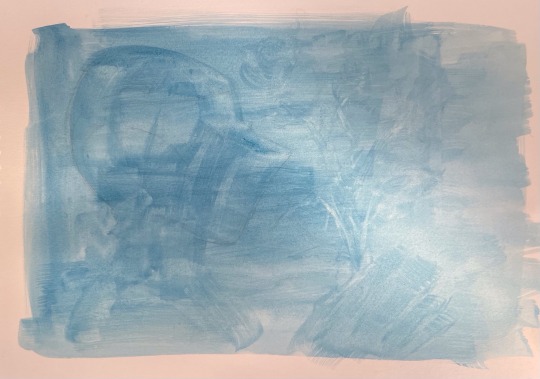
I like to start with the darkest areas! usually this is around the studs, or the ‘seams’ (if there are technical names pls let me know 🙏). I try not to focus on one area too much at once just to keep everything proportional and remind myself of the overall form! India ink is fab because it dries so quickly, and as far as I’m aware it doesn’t lift once dried, so I can go over the fine details to add reflections and shading! when I do the shading, I treat the ink like watercolour - I dilute it heavily, going from light to dark. you can always add more pigment later!
I always forget to take photos as I go along, but hopefully this kind of illustrates what I’m yapping about

I was very silly and forgot to take my brushes with me to uni… buuuut from memory, I think it’s a ‘round’ brush? it can carry a lot of ink but tapers to a very fine point at the end, allowing for the teeny tiny details on the armour, as well as the larger washes of pigment. this is a4 paper for scale (I think that’s around 8.5 x 11 inches!) I use a bigger round brush for bigger areas! I also loosely sketch out the details in pencil before painting but the drawing is usually more ambitious than what I can realistically achieve at this scale - the squiggly lines were the hardest! I tended to depart from the reference at this point and make up some organic shapes. basically the smaller scale means it’s no biggie if you do make a mistake!
I use bristol paper - super smooth surface that holds the ink really well!
it’s a little different for my first knight though (below)! still started with the blue gouache wash, but I used fine liner pen. I think it’s either 0.5 or 0.3 - leaning towards the latter just because of the smaller details! this is a less forgiving medium imo, but super satisfying. I used black gouache to fill in the background for this one - I didn’t have any inks at this point. I’m working on a5 paper here in a moleskine notebook, so it wasn’t really meant to be damp.
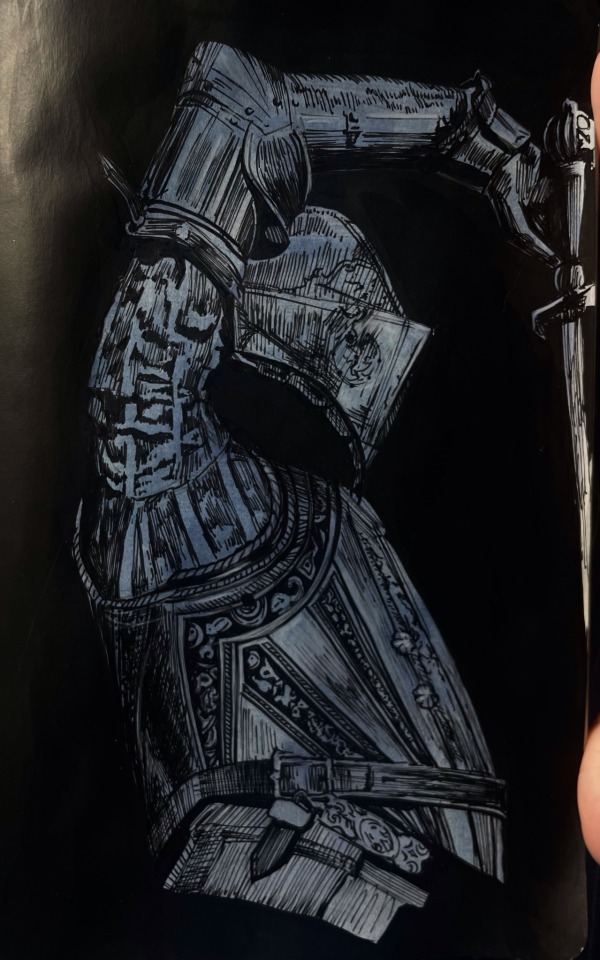
also I am still bad at taking photos of my art - but I am getting better! I scanned the painting, then adjusted the shadows (just using the photos app). literally the only edit is turning ‘shadows’ down to -100, but you can see how much of a difference this makes! I’m including this because it’s always so disheartening when the camera doesn’t pick up the artwork properly. something I struggle with when using ink is getting an even surface with large areas of undiluted black, which is why I tend to adjust the contrast. if anyone has any tips on this I would appreciate it!

apologies for the very long post - if there’s anything else I can clarify please let me know!! I’m quite new to tumblr so sorry if the formatting of this post is a little off.
unfortunately I have just gone back to university, so it will probably be a while before I have some art to post - I also left all my art supplies at home… whoops! maybe this is a chance to improve my digital art!!
and thank you so so much for all the notes on my previous post! I read every tag on reblogs and they always make my day <3
60 notes
·
View notes
Text
Outcaste Nakshatras: The Outsiders (part 3)
Here's part 1 and part 2
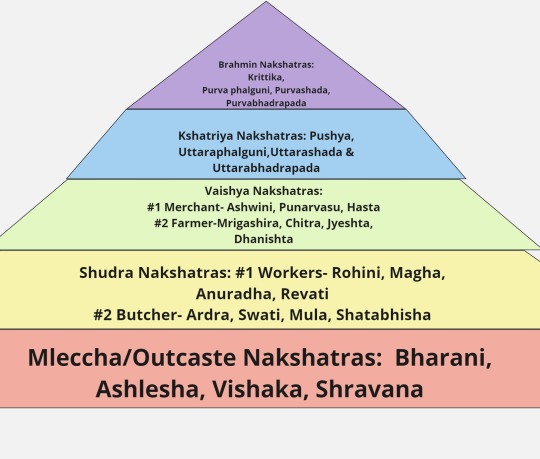
The more I study Mleccha nakshatra natives and the art they make, the more I understand how deeply lonely it is to have a Mleccha nak (Bharani, Ashlesha, Vishaka, Shravana) and I really feel for them. To live your whole life feeling misunderstood and othered is so difficult.
The movie Edward Scissorhands is a really good example of the "outcast" trope. The titular character is played by Johnny Depp who has Ashlesha Rising and his love interest is played by Winona Ryder who has Mercury (amatyakaraka) & Venus (atmakaraka) in Vishaka
I find Outcaste nak pairing very interesting because obviously you only feel like you belong/truly feel accepted in the presence of another Outcast.
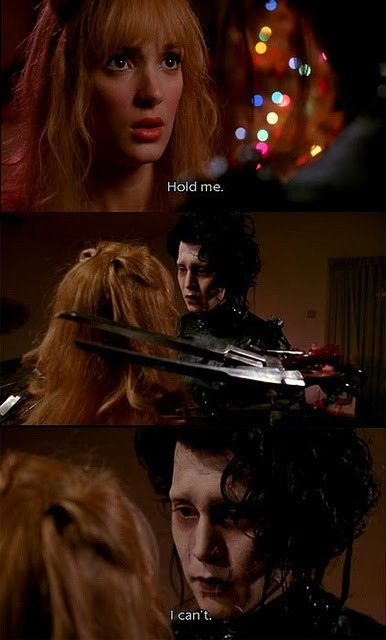
Sidharth Malhotra, Vishaka Moon is married to Kiara Advani, who has Mercury & Venus (atmakaraka) in Ashlesha (if you have 2 or more planets in the same nak that energy is very concentrated even if its not your big 3)

they're both known for being pretty low-key people which is unusual in Bollywood lmao
Sid is an "outsider" which is what we call non-nepo actors in India. imagine the extent of nepotism in cinema in India that its the exception to be an "outsider"lmao. anyway Sid is pretty reserved and introverted and is known for not fitting in with the Bollywood crowd. Kiara is also kinda like that I guess but idk too much about her personality. They both seem happy together tho
Kareena Kapoor, Shravana Moon is married to Saif Ali Khan, Ashlesha Sun & Shravana Moon

Kareena's parents are famous actors who are separated (her dad was misogynistic and abusive and didn't want women to act) and even tho she's a nepo baby she didn't grow up with the same privileges as others in her famous family. Her elder sister had to drop out of school to support the family by acting as they were raised by a single mom and had fallen on bad times. You can see how the "outcast" themes were present in Kareena's life even though she's a very privileged nepo baby
Saif is also a nepo baby (welcome to bollywood lol) but he married a much older actress when he was 21 and had two kids. they later got divorced and Saif received a ton of bad press for alleged adultery, not getting custody or visitation rights of the kids, not paying child support (the amount was absurdly high tbh) etc he didn't fit in with the other actors of his generation. The media & public went crazy when news of Saif & Kareena getting married came out bc Saif is a divorcee with 2 kids (this stuff is still taboo in India unfortunately) and Kareena is one of the most successful stars of her generation. But they've been married for 10+ yrs and have 2 kids and are as happy as ever.

Even Kareena's longterm ex-boyfriend, Shahid Kapoor was a Mleccha caste nak guy (he has Vishaka Moon)
Expanding on the outcast tropes, Shahid's parents separated when he was young and he saw little of his biological father. He had to work very hard for very long to break into the industry and even now, he's not really given his due as an actor.
Alia Bhatt, Shravana Rising is married to Ranbir Kapoor, Shravana Moon

their marriage seems hella toxic to me ngl BUT they've both had similar childhoods.
Alia & Ranbir are both nepo babies (welcome to bollywood), Alia is like a tier 3 nepo (her father is a notoriously controversial filmmaker) whilst Ranbir is like a tier 1 nepo (he is a 4th generation actor from the biggest film family in India) however both their parents had unhappy marriages, and both of them had abusive fathers. trauma bonding, mayhaps? they're both also extremely close to their mothers as well (Moon dominant people often tend to be)
Its another example of Outcaste naks bonding over their shared experiences/feelings of being the outcast.

all members of Blackpink have an Outcaste nakshatra in their chart that is prominent in some way.
Jisoo- Shravana Moon, Venus in Vishaka (darakaraka), Ketu in Bharani
Rose- Venus conjunct Jupiter (debilitated) in Shravana
Jennie- Vishaka Moon, Mars in Shravana
Lisa- Jupiter in Shravana (debilitated), Swati Moon (Swati is a Shudra nak, which is the lowest caste so the themes are similar to that of outcaste naks)
This is interesting to me because BP is the biggest girl group of all time yet they are also probably disproportionately hated for things they cant even control. they were mismanaged by a shitty ass company with very few comebacks and barely got to display their true calibre as artists and their media interactions, promos, other activities etc were severely controlled and restricted. all of this is to say that despite being the most successful group their actual experiences are far from sunshine and roses. they were treated like outcasts by their company and the industry and fans. they trained for 4-6 years, enduring a brutal and toxic system, worked very hard with what they were given, with 0 creative liberty to come this far im glad theyre pursuing solo careers now and hope to see them thrive<333

the movie Lost in Translation is a good example of two outcasts/lonely people who find comfort in each other
Bill Murray is Shravana Moon and Scarlett Johansson is Vishaka Moon

Sridevi, Ashlesha Sun & Rising and Boney Kapoor, Vishaka Sun & Mercury
So they had a really fcked up marriage that I won't get into but they were both people who felt like outcasts in their lives. Sridevi grew up with a stepfather and was pushed into acting by her mother when she was 3-4 years old (she's like an Indian Judy Garland tbh) who deprived her of formal education and a normal life so that she'd be the family cash cow. Being South Indian, she also found it hard to fit in among Bollywood folks as she initially spoke neither Hindi nor English. Boney's the ugly duckling of his family and his younger brother is one of the most famous/iconic actors ever, he had to become a movie producer since his brothers became actors and his father (who was a movie producer) thought it would be better if he stayed behind the scenes. themes of exclusion and outcast-ness crop up in their lives and in the lives of all the people I mention here.

Lady Bird is a good example of a movie about a female teenage outcast. The titular character is played by Saoirse Ronan, who has Bharani Moon
Recently I came across the content creator, Alana Lintao who often makes shorts about social behaviour. This one in particular stood out to me because its literally about one person being excluded by a group of friends or being treated like "the other".
Alana plays the excluded friend in this short as well. She has Bharani Sun, Swati Moon and Mercury in Revati amatyakaraka (Swati & Revati are both Shudra naks)
Outcaste naks are vilified and crucified for mistakes others get away with.
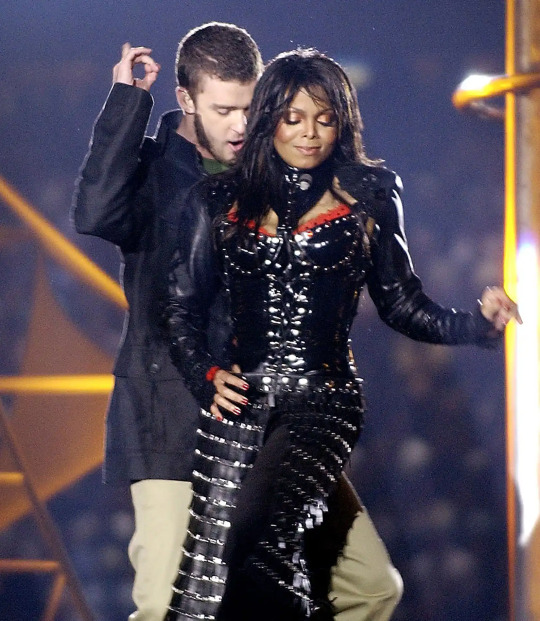
Janet Jackson, Vishaka Rising & Ketu
Janet's career took a hit and her life took a tumultuous turn after the Superbowl incident. She did not deserve all the vitriol she received then especially considering how so many others get away with wayyy worse

Jennie, Vishaka Moon gets hated on for absolutely nothing
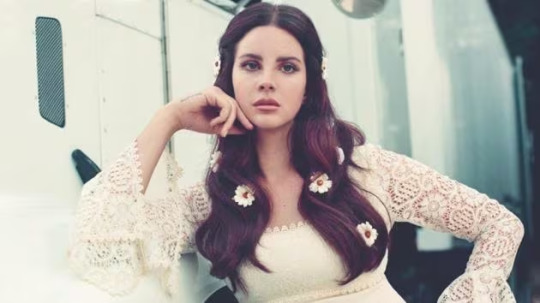
Lana Del Rey, Ashlesha Moon, Vishaka Rising (&stellium)
Lana does say dumb things from time to time but she gets soooo much unnecessary hate
I have noticed how Outcaste nakshatras often tend to have really difficult childhood experiences

Jeanette McCurdy- Ardra sun, Bharani Moon & Pushya Rising
Jeanette opens up about her abusive mother and terrible childhood in her memoir. I mention her other placements as well because I've noticed that both Ardra & Pushya natives also experience abuse in their early lives

Britney Spears, Shravana Moon
she has endured so much abuse from so many people including her family. i wish her peace.

Wheein, Vishaka Moon grew up with a single mother and later after she made her debut her estranged father tried to borrow money from people under her name?? there was a minor scandal about it many years ago. She also grew up quite lower middle class if not poor.
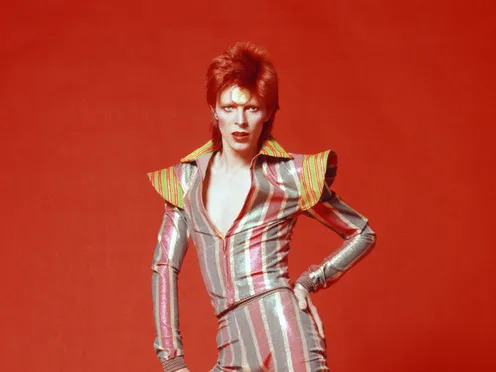
David Bowie, Shravana Rising
Bowie once said, "“It wasn’t a particularly happy childhood, my parents were cold emotionally. There weren’t many hugs. I always craved affection because of that.”

Cole & Dylan Sprouse, Ashlesha Sun
Speaking on the Call Her Daddy podcast, he explained that their mother's issues with mental health and addiction contributed to her being "financially the most irresponsible woman ever." He said that when their dad was given forced custody when the boys were 10, their mom had already spent everything they'd earned from their early acting jobs. Though their dad wanted them to be "normal kids," he ultimately decided that the boys' acting careers were a financial necessity.

Ariel Winter, Shravana Sun
Ariel Winter has spoken out about how acting wasn't her choice, but it was her mother's. Ariel shared that her mother, Crystal Workman, had dreams of being an actor herself. Ariel said that with Crystal as her stage mom, she dealt with a lot of abuse and exploitation.
Once Ariel's acting career began, she said her mom put her on a strict diet and neglected her education. Her mother also had her dress in outfits that sexualized her. Ariel claimed her mom put her in “the smallest miniskirts, sailor suits, low-cut things, the shortest dresses you’ve ever seen. People thought I was 24 when I was 12. If there was going to be a nude scene when I was that age, my mother would have a thousand percent said yes.”
Now Bollywood is an industry run by film dynasties, its very rare for someone from the outside to break in and make it big. Being an "Outsider" is very difficult, people bully you, try to sabotage your career, try to isolate you etc etc, needless to say its not for the faint of heart. So lets take a look at some of the most successful "Outsiders" in Bollywood who made it big without any family in the business

ofc we have to start with the most successful outsider of all time, Shahrukh Khan, Shravana Moon
he truly came from nothing (father died when he was a teenager, mother died before he made his debut, has a sister with special needs who he has taken care of his entire life) and became the biggest star in the world.
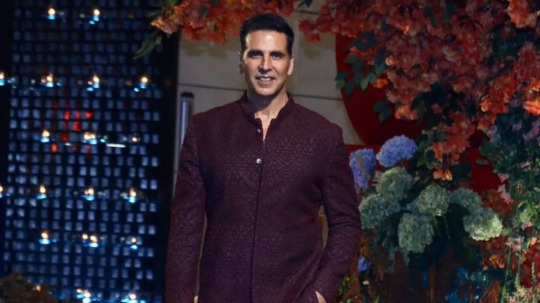
Akshay Kumar, Vishaka Moon, he was a martial artist, chef, waiter and worked numerous odd jobs before he started modelling in his late 20s and later started acting and today he has a net worth of $340 million

Anushka Sharma, Bharani Sun
her life is truly a case of being lucky af, she was a model and by the age of 19-20 she was cast in a film opposite Shahrukh Khan aka the biggest actor in the country produced by YRF, one of the biggest film production companies in India. its truly a fairy tale because neither can Anushka act nor is she gifted in any other way (bad dancer, heck she was even an awful model) but she's incredibly successful in every way and is now married to the (former) Captain of the Indian cricket team

Deepika Padukone, Shravana Rising
she is from a privileged background (her dad's a renowned badminton player) but she worked very very hard to get where she is today and has had more career longevity than just about any other actress.

Bipasha Basu & John Abraham, Bharani Moon
they were both a hot couple who were really popular in the 2000s
there are many other successful Outsiders but they don't have outcaste naks lol, these are the only ones i can think of rn :/
i hope this post was informative<33
#astrology notes#astrology observations#sidereal astrology#vedic astro notes#nakshatras#astro notes#vedic astrology#astrology#astroblr#astro observations#jyotish#shravana#bharani#vishaka#ashlesha
288 notes
·
View notes
Text
If you're from Argentina, you've probably heard about the Iberá wetlands, and you know the tourist pitch: a vast expanse of natural wonders in the middle of Corrientes, full of beautiful lapachos, cute carpinchos and yacarés, and now home to the fastest-growing wild yaguareté population, all with the unique Guaraní influenced culture of rural Corrientes.
Now, things aren't as shiny as they look, since the creation and management of the new national park is still a point of contention in many ways, but you will be suprised that this kind of thinking about the Iberá is very, very recent. Most people considered it an obstacle to progress, a big bunch of swamp in the middle of what could be a very productive ranching province. In a geography book from the 1910s (unfortunately I lost the screencap) it says something like "the biggest obstacle for the development of the province is this swamp, and it should be drained"
This took me to the other side of the world, to the Netherlands. They're known for land reclamation, from literally building their country from the sea. Especially when we're facing rising sea levels because of climate change, the Dutch seem like miracle workers, a look into our future. You will find no shortage of praise about how with some windmills and dams, the Dutch took land "from the sea", and turned it into quaint little polders, making a tiny country in Europe a food exporter and don't they look so nice? But when you look about it, you can barely find anything about what came before those polders. You have to dig and dig to find any mentions of not "sea", but of complex tidal marshes and wetlands, things I've learned are ecologically diverse and protected in many places, but you won't find people talking about that at all when talking about the Netherlands. It's all just polders now. What came before was useless swamp, or a sea to be triumphantly conquered. It's like they were erased from history
The use of that language reminded me of the failed vision of draining Iberá... and the triumphing vision in the Netherlands, and many other places. Maybe those wonderful places, those unique wetlands, would have been a footnote, you wouldn't find anything unless you were a bored ecologist who looked, and not even then. Now, far it be from me to accuse the medieval Dutch, who wanted to have more space to farm, of ecocide. And don't think this is going to be a rant against European ecological imperialism either, as the most anthropized places you can find are actually in China and India. But it does get me thinking.
I work with the concept of landscape, and landscape managing. (Not landscaping, those guys get better paid than me) The concept of landscape is somewhat similar to the concept of ecosystem you know from basic biology, but besides biotic and abiotic factors, you also have to involve cultural factors, that is, humans. There is not a single area of "pristine" untouched nature in the world, that is a myth. Humans have managed these landscapes for as long as they have lived in them. The Amazon, what many people think about when they think about "unspoilt" nature, has a high proportion of domesticated plants growing on it, which were and are still used by the people who live on it, and there once were great civilizations thriving on it. Forests and gardens leave their mark, so much that we can use them to find abandoned settlements. From hunter-gatherers tending and preserving the species vital to their survival in the tundra to engineers in Hong-Kong creating new islands for airports, every human culture has managed their natural resources, creating a landscape.
And this means these landscapes we enjoy are not natural creations. They are affected by natural enviroments; biomes do exist, species have a natural distribution. But they are created and managed by humans. Humans who decide what is valuable to them and what is not. The Dutch, seemingly, found the tidal marshes useless, and they created a new landscape, which changed the history of their nation forever. We here in modern Argentina changed our perception of Iberá, decided to take another approach, and now we made it a cherished part of our heritage, which will also speak about us in the future.
Ultimately, what is a useless swamp to be drained or a beautiful expanse of nature to be cherished depends in our culture, in us humans. We are the ones who manage and change ecosystems based in our economics, our culture, our society. This will become increasingly important, as climate change and ecological degradation becomes harsher and undeniable. We will have to decide what nature is worth to us. Think about what is it worth to you.
#I REALLY had to restrain myself not to make a football joke about the netherlands#cosas mias#ecology#biology#culture#cultural landscapes
163 notes
·
View notes
Text
Indian IT Worker Designs New Eco-Friendly Sewage Treatment Method with the Sacred Cow as His Inspiration https://www.goodnewsnetwork.org/indian-it-worker-designs-new-eco-friendly-sewage-treatment-method-with-the-sacred-cow-as-his-inspiration/
Tharun Kumar began to imagine ways to build a better sewage treatment method that could produce good quality water without chemicals.
In 2017, Kumar started ECOSTP with the chambered stomach of the cow as his “bovine inspiration.”
Typical wastewater plants use aerobic bacteria, or metabolism with oxygen, to break down sewage, but this requires the ventilation system that continually runs on energy. Regular sewage treatment also tends to use chemicals, and has the presence of a full-time employee. Kumar has eliminated almost all of these drawbacks.
At the base of the ECOSTP septic tank is a layer of cow dung that provides the bacterial workers. With the water moving via gravity, it enters the second bacterial chamber before passing into the third space which is a filter of sand and gravel. The fourth chamber lies under a garden of select vascular plants which removes suspended solids, pathogens, nitrogen, and phosphorus, the latter two going to feed the plants.
The resulting water is graded by health inspectors as good quality for toilet water and gardening applications. With the aid of a grant from the US-based Biomimicry Solutions, ECOSTP now has 325 clients across 22 states in India, and their septic tanks are unmanned and unpowered, saving thousands in running costs.
“We are proud to have reclaimed 2 billion liters of sewage so far without power or chemicals.”
ECOSTP is now seeing if it’s possible to identify anaerobic bacteria that can remove the harmful compounds of industrial effluent.
youtube
#good news#science#microbiology#india#waste water treatment#wastewater#green technology#biomimicry#environmentalism#environment#nature#animals#climate change#climate crisis#Youtube
255 notes
·
View notes
Text
A MISSING PIECE IN THE BIG BANG THEORY HAS SURFACED??
Blog#411
Wednesday, June 19th, 2024.
Welcome back,
Combining different pieces from Big Bang cosmology could help explain an issue we have today.
The Hubble constant, the speed of expansion of our universe, is not observed with consistency.
These scientists suggest that not-well-understood quantum gravity could account for the gap.

In research published earlier this year, physicists from the University of Hyderabad in India say they’re on the path to solving one of the universe’s biggest outstanding problems. Since Edwin Hubble realized the universe is always expanding nearly 100 years ago, scientists have used the “Hubble constant” in calculations on virtually every scale in the universe.
But today, estimates for the Hubble constant don’t always align, with a difference of up to 10 percent between calculations made using different methods. (When someone at NASA mixes up meters and yards and loses an entire spacecraft, that’s not even a full 10 percent deviation.)
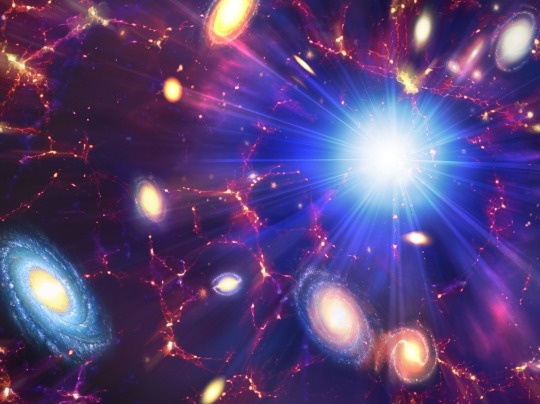
The paper appears in the peer reviewed journal Classical and Quantum Gravity. The journal has an ongoing, periodically updated “focus issue” specifically about this measurement tension, and the editors explain the problem there—scientists can’t say for sure that the different Hubble constants measured are actually different, rather than just observation or calibration issues.
But the authors of the new paper, physicist P.K. Suresh and his research fellow (referred to as just Anupama B.) say that most measurements taken now are reliable. Instrumentation only continues to improve—we’ve all seen those generation-defining, poster-quality photos of the far-out planets, for example. If the measurements on the local and faraway levels are indeed sound, then something is missing.

It’s here where they introduce quantum gravity as a possible factor. This variable—which, to be honest, is another enigmatic “placeholder” in some ways—could close the gap in Hubble constant observations. That’s because, as the authors propose, quantum gravity could have affected the rate of change at which the universe expanded itself. When a constant can have a variable rate of change, it’s easy to see why researchers tend to drop the ‘constant’ label and instead call the fatcor simply H0, H1, and so on to designate which version of the measurement is in play.
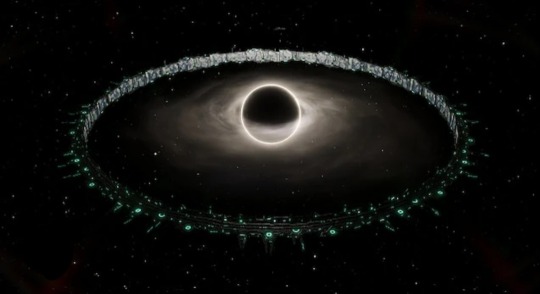
The researchers explain that during inflation—the rapid growth of the universe immediately following the Big Bang—there may not have been a single, uniform inflation zone. Instead, more and more scientists are theorizing around the idea of “multi field” inflation. The idea originated to explain another measurement discrepancy: the number of particles in particular places or times, compared with the massive speed of inflation overall.

If a theory could help explain one gap in our codified equations for how inflation works, it makes sense to try that theory to find other missing pieces. These researchers used what is called the hybrid inflationary model, which describes two fields: one inflating and one rolling over like a waterfall. By accounting for quantum gravity, they found they were able to reconcile H0—the current Hubble constant—with both H1 (during inflation) and HT (during phase transition). Just one adjusted equation with a parameter for quantum gravity could draw a curve that includes all three data points.
Originally published on www.popularmechanics.com
COMING UP!!
(Saturday, June 22nd, 2024)
"WHAT IS THE OLDEST BLACK HOLE IN OUR UNIVERSE??"
#astronomy#outer space#alternate universe#astrophysics#universe#spacecraft#white universe#space#parallel universe#astrophotography
74 notes
·
View notes
Text
A bit of announcement and insight into my future plans here. Long read so I'll put read more line
Some of you may have noticed I haven't written Genshin fics for a while. The reason is really just I have lost interest in the game, i still have it but I didn't log in this entire patch and was on and off before it too. Literally didn't even pull Mavuika despite having a guarantee and enough time to farm primos. Many things have bothered me about it for a while, Natlan as a whole didn't pull me in and I just couldn't anymore.
Nevertheless, I still love my waifus in it and won't give up writing them. Genshin started my fanfic journey so I can't really drop it so easily. I'll probably continue to not write Genshin content for a while more, hoping to reignite my passion for the game. The requests I have are all so good so I definitely have the interest to do them, just need motivation. Ptn and hsr content would probably take the front seat for a while, especially ptn since I have an on and off relationship with hsr too.
Currently I'm obsessing over Aglaea and Jade in hsr so they'll keep me motivated for it. But if I don't get another fave in Amphoreus then it's gonna go down. Ptn, however, will stick around all the time. Never dropping this game and I know I'll keep getting new faves it's just that good and appeals to me so much. Aside from this, I play wuthering waves and aether gazer most so I can do requests on them as well. I tend to try most new gachas and get into some of them so you are welcome to ask me if I have a new fixation lol.
Ok moving onto some personal stuff. Starting from 17th February, I will be going out to pursue my master's degree. First I have a 3 days long travel then over there I'll be settling stuff until my course begins on 3rd March. Hence, I won't be posting much- if at all- during the second half of February and early March. After that it depends on the schedule I have there, probably gonna be pretty slow for a while cause it's a new place for me and I need to do many things on my own away from home. I'll keep you all updated how it goes, and if I can write then I'll just post as usual.
Thank you for your support it's honestly so amazing being here, you all are amazing I'm blessed to have such readers. Oh also to those who wish to donate to me or even commission me- I'll be in a different country for my degree and will try to set up patreon or something there since those apps aren't available in India. It'll be helpful for me to have some income from this 😊 thank you once again you guys, love you all ❤️
#kuro's announcement#path to nowhere#genshin impact#honkai star rail#kuro's thoughts#genshin x reader#hsr x reader#ptn x reader
37 notes
·
View notes
Note
Hi there. Idk if this question has been asked before, but where do they find the fabric for the mandarin coat?
I'd say there are as many answers as there are versions of the costume. But some pointers:
Many of the early versions were made with partly antique embroidered textiles from the Qing dynasty. These were a popular collector's item in the 19th and 20th century, to the point where some of them were never intended for use in China, they were made as souvenirs. The original design by Maria Bjørnson suggests antique Chinese fabrics, with a hem showing the classic water-and-mountain motif, the collar being a cloud collar usually seen in women's attires, and the hat a decorated winter hat.

Even if all these costumes are made from scratch rather than bought, I thought it could be interesting to compare it to a similar authentic Chinese robe - without the collar - dated to the 1890s and sold by Augusta Auctions some years ago:

This robe has a badge - an insignia of rank and position of a Mandarin official in the Qing dynasty. These were used both on the chest and back, and the bird or otherwise animal told onlookers all they needed to know, if the person was a civil or military employee, and how high up in the system they were. The badge is not featured in Bjørnson's design, but it has showed up in a few costumes. Maybe most proninently in Michael Crawford's original West End costume, which Bjørnson would have supervised:

To my eye it looks like many of the elder costumes (up until c. 2005) used a lot of antique or vintage fabrics, but used on a new base. Details to look for is distinct gold couching, re-used badges, special dragon embroideres, antique collars and tabards, fringework etc. I am quite convinced some of these are antique or vintage details, like the China blue tabard with water and mountain motif used by John Owen-Jones in West End c. 2002:
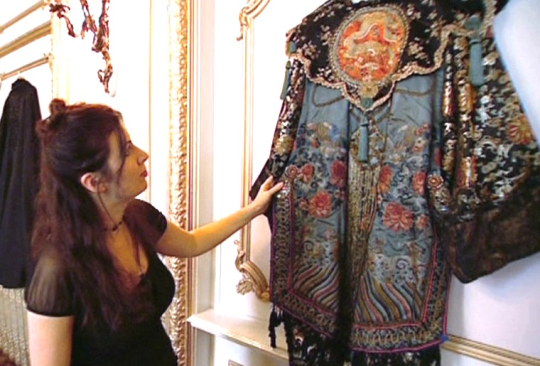
The cuff and details on one of the original Australian robes, and continued to shine in the World Tour up until 2015 or so:
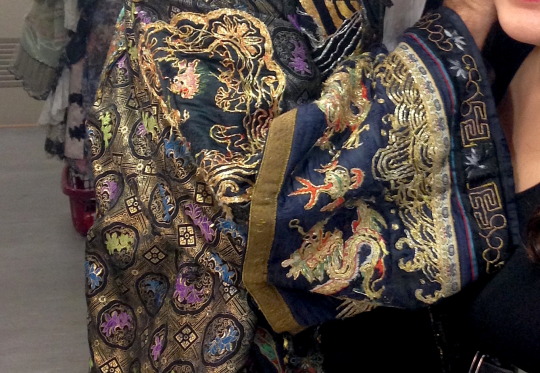
The tabard of the Swedish/Danish version, first made in 1989 and still in use in 2019 (maybe not too visible in the stage photo, but definitely when seen up close backstage!):

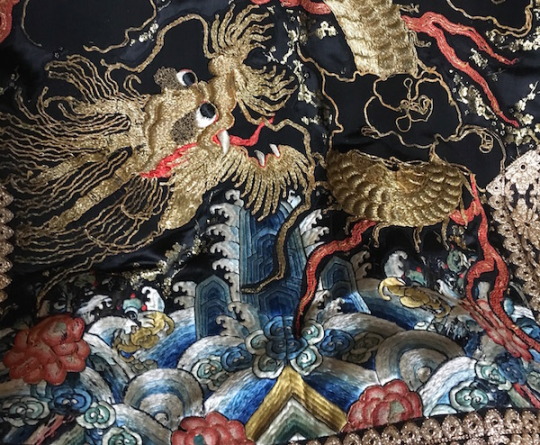
As a contrast, newer costumes tends to be brassier and bigger, with less embroidery and more appliquées and trims. It looks to me like they mostly rely on new fabrics and materials, maybe with some elements of elder embroidery. This collar made for Ben Lewis in West End is a good example:
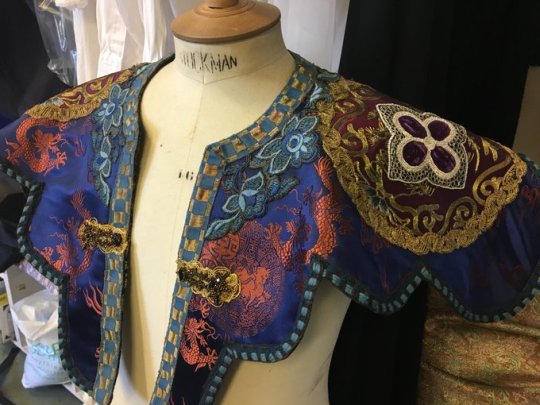
And the recent German version, here seen on Mathias Edenborn in Hamburg. It's a costume I got to study up close and I couldn't spot any particular details that looked old:

And this Broadway robe with what looks like a very new firefly pattern brocade and embroidered gold trims appliquéed on:

So why this change? I guess it depends on what is available. Qing textiles has become more rare on the open market, and more expensive. Elder textiles are also more fragile, while new textiles will handle wear and tear, dry cleaning etc. better. Some of these costumes are used on stage up to eight times a week, after all.
Due to the fragility of elder textiles, they may have to cover the embroidery with fine mesh. This dulls down the effect and makes the costume heavier, so it's not always ideal. Better then to use new stuff. Here's an early 1990 West End one covered with mesh, to protect the embroidery:
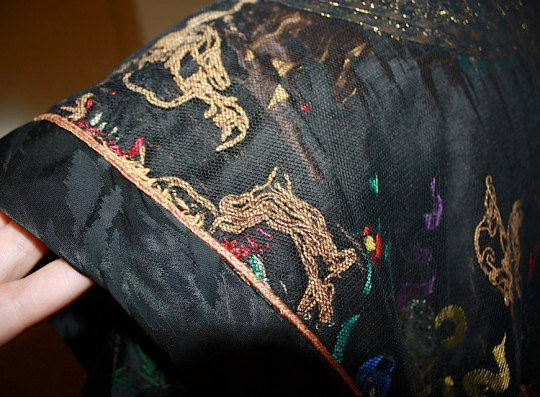
A last aspect is of course that by using elder textiles you may put specific meaning-bearing motifs on which ideally shouldn't be there. The beautiful embroidered Indian fabric with elephants and swastikas - in India a symbol of the sun and good luck - which appeared in an unfortunate Danish Elissa skirt is a good example. Luckilly the costume crew knew what they were doing by including the five bats - for good luck - on this Broadway Mandarin robe:

If you plan on making your own costume, I would say: Create the base of a Chinese brocade (silk or synthetic) with predominantely black or dark blue base and polychrome pattern. As an inspiration, here's the robe, collar and tabard - fairly undecorated - in making for Scott Davies (top) and Ben Lewis (bottom) in West End, with photos generously shared by head-of-costume Ceris Donovan:


For the back: Go for a main motif, and build everything around that. And layer! Gems upon trims upon embroideries upon fabrics. The more structure, embroidery, couching and details the various materials has, the better. And then add some on top of that.
Note that it varies if a production do both the robe, cloud collar and tabard. Some production only do two of these, some do all three. But whatever the case, the costume with hat should create angles, texture and lines that makes him stand out from the previous scene, where he wore black and white and tight-fitting clothes.

In West End I think they source it in the many amazing fabric shops in Brixton and Soho, including Borovicks, as well as antique dealers. For Broadway I know a lot was bought in the fabric district in NYC. Other productions may be equipped with fabrics and trims from these, or they may source their own materials locally. I also noticed that the Chinese (left) and Japanese (right) productions tend to use more red and purple fabrics for their versions, which I would think was also locally sourced:

So yeah. As many answers as there are versions out there...
61 notes
·
View notes
Text
“It is no longer simply the merchant prince, or the aristocratic monopoly, or even the employing class, that is exploiting the world: it is the nation; a new democratic nation composed of united capital and labor. The laborers are not yet getting, to be sure, as large a share as they want or will get, and there are still at the bottom large and restless excluded classes. But the laborer’s equity is recognized, and his just share is a matter of time, intelligence, and skillful negotiation.
Such nations it is that rule the modern world. Their national bond is no mere sentimental patriotism, loyalty, or ancestor-worship. It is increased wealth, power, and luxury for all classes on a scale the world never saw before. Never before was the average citizen of England, France, and Germany so rich, with such splendid prospects of greater riches.
Whence comes this new wealth and on what does its accumulation depend? It comes primarily from the darker nations of the world—Asia and Africa, South and Central America, the West Indies and the islands of the South Seas. ... The difficulties of this imperial movement are internal as well as external. Successful aggression in economic expansion calls for a close union between capital and labor at home. Now the rising demands of the white laborer, not simply for wages but for conditions of work and a voice in the conduct of industry, make industrial peace difficult. The workingmen have been appeased by all sorts of essays in state socialism, on the one hand, and on the other hand by public threats of competition by colored labor. By threatening to send English capital to China and Mexico, by threatening to hire Negro laborers in America, as well as by old-age pensions and accident insurance, we gain industrial peace at home at the mightier cost of war abroad.
In addition to all these national war-engendering jealousies there is a more subtle movement arising from the attempt to unite labor and capital in world-wide freebooting. Democracy in economic organization, while an acknowledged ideal, is to-day working itself out by admitting to a share in the spoils of capital only the aristocracy of labor—the more intelligent and shrewder and cannier workingmen. The ignorant, unskilled, and restless still form a large, threatening, and, to a growing extent, revolutionary group in advanced countries.
The resultant jealousies and bitter hatreds tend continually to fester along the color line. We must fight the Chinese, the laborer argues, or the Chinese will take our bread and butter. We must keep Negroes in their places, or Negroes will take our jobs. All over the world there leaps to articulate speech and ready action that singular assumption that if white men do not throttle colored men, then China, India, and Africa will do to Europe what Europe has done and seeks to do to them.
On the other hand, in the minds of yellow, brown, and black men the brutal truth is clearing: a white man is privileged to go to any land where advantage beckons and behave as he pleases; the black or colored man is being more and more confined to those parts of the world where life for climatic, historical, economic, and political reasons is most difficult to live and most easily dominated by Europe for Europe’s gain."
W. E. B. Du Bois, "The African Roots of War" (1915)
23 notes
·
View notes
Text
It will always be easier for you to awaken your kundalini and touch into other spiritual states naturally when you have worked towards having healthier biology and physiology. I know this world likes to distract us from being the healthiest versions of ourselves. Porn, alcohol, sugar, cigarettes, and bad sex have never been easier to come by therefore you have to be a bit of a warrior if you want to get healthier. No perfection-seeking required.
At any given moment, we can rebirth ourselves through our bodies. Reincarnation is what we are up to in this new earth. Because when we were younger, many of us exited our bodies. To be fully inhabited back then could have hurt us with irreparable damage.
However as grown women, the healing is allowing ourselves to come back into our bodies more fully and reduce or eliminate all coping mechanisms for being human. We can not just be spiritual. We have to exercise and weight train and build actual real muscle. at some point.
For example, when we are stronger and more awakened in our core, we tend to have more blood flowing through our gut, and better mental health as a result. For many of us, the aim is to learn the basics of what it means to live in a healthy female body, like eating enough food so that our body has the sufficient amount of nutrients necessary to create real energy.
We must become interested in fully inhabiting our body again. We can't just intellectualize about the planets all day. At some point, we have to stop talking and stretch open our pelvis and thighs like the round planets we naturally are.
—India Ame’ye
92 notes
·
View notes
Note
Lieutenant! Can you tell us about Cape Horn and why it was so dangerous?
Of course I would,
So let's get to the location:
Cape Horn is located at 55° 59′ south latitude and 67° 17′ west longitude. The headland is located on the rocky island of Isla Hornos (Horn Island, not to be confused with the Horn Islands in Micronesia, also discovered by Schoutens), which belongs to Chile, and is the southernmost point in the Tierra del Fuego archipelago. Like the southernmost 2,000 kilometres of South America, it lies in the cold Antarctic circumpolar current. Unlike South Africa, which is twenty degrees further north with the warm Agulhas Current, Tierra del Fuego is never reached by a warm Atlantic current (Brazil Current). Instead, the cold polar current (Falkland Current) reaches as far as the Río de la Plata in the southern summer and as far as southern Brazil in the winter, meaning that Cape Horn is under the influence of a large-scale subpolar current all year round.
The air temperature at Cape Horn is almost identical to the water temperature all year round - day and night - which is 8 °C in January and 5 °C in July. During the day, it rarely gets warmer than 12-13 °C. There are only occasional frosts in winter and it almost never snows, although it rains over 280 days a year.

With few exceptions, the wind blows from the western half of the compass rose all year round; easterly winds are very rare. However, the wind force in the sea area around the Cape tends to be lower than in the neighbouring south-east Pacific and off the Chilean coast near the Strait of Magellan, for example, where there is always one wind force more and twice as much chance of storms. Nevertheless, the wind blows almost constantly in summer (January) with at least five Beaufort, but only once a month with more than seven Beaufort, and once a week to the west. In July, at least seven Beaufort and one storm per week are recorded every third day, while two storms per week can be expected to the west.
The Cape was rounded for the first time by an expedition of Dutch sailors Willem Cornelisz Schouten and Jakob Le Maire on 29 January 1616, sailing on behalf of the Australian Company, which was founded by Jakob Le Maire's father Isaac Le Maire together with other Hoorn businessmen after an internal dispute with the Dutch East India Company (VOC). As Dutch ships at the time were only allowed to use the Strait of Magellan if they belonged to the VOC, Isaac Le Maire was looking for a passage to the Pacific untouched by the rights of the VOC to trade with the East Indies Spice Islands.
The expedition's mission was to explore a new route to the ‘East Indies’.It was considered fulfilled when a passage opened up between Tierra del Fuego (in the language of the Spanish owner) and the hypothetical huge southern continent of Terra Australis.It was named Fretum le Maire (literally Le Maire Strait) in Latin in honour of the initiator and most important financier Isaac Le Maire, and the ‘peninsula’ to the east belonging to Terra Australis was given the name Staatenlandt in honour of the newly constituted Dutch parliament.The rededication in favour of the son Jakob Le Maire took place after his tragic death at the instigation of his father.The island character of Staatenlandt, which is only sixty kilometres long, could not be recognised, as even at sea you can rarely see further than about forty kilometres. Not being able to see the connection of the state island to the huge Terra Australis only proved that one could not see further than twenty nautical miles - and this was already known.
According to the published records of the ‘shipwrecked passenger’ Jacob le Maires (his expedition ship, the Hoorn, burnt up during cleaning work in Patagonia), he and Captain Schouten were of the opinion that Tierra del Fuego was a rugged, rocky but contiguous island, the supposed southern tip of which was named Capo Hoorn in Latin by Schouten, who was responsible for it, in honour of the second great financier, the council of the city of Hoorn.The Le Maire Strait, the short and easy passage between America and Terra Australis at Staateninsel or Staatenlandt, was the important discovery; Cape Horn was already a clear 180 kilometres into the Pacific. Isaac le Maire had the discovery of this passage, supported by a ‘silent’ Schouten, attributed to his son by court order, with the father as heir.However, the associated and desired exploitation rights of the strait were immediately expropriated and granted to the monopoly of the East India Company.The last lawsuits over this were lost in 1648.
With the realisation that even Staatenlandt was not connected to Terra Australis and that Cape Horn was the decisive landmark, neither the Strait of Magellan nor the Le Maire Strait could be permanently managed with customs duties. Due to the factually and historically incorrect, commercially motivated court judgement that Jacob le Maire found his way into the Pacific via the Le Maire Strait, the discovery of Cape Horn is attributed to him just as incorrectly and abbreviated. Usually, however, all discoveries made on such a voyage are attributed to the captain, as he decides which unknown waters his ship sails into, is responsible for them and also has to assess and interpret what he sees. However, Schouten did not insist on a public acknowledgement of his exploratory achievement, presumably due to an ‘agreement’ between him and Isaac le Maire. In addition, the published documentation of the voyage was undoubtedly written by the representative of the shipping company Jacob le Maire, so that the impression of a discovery by the travelling merchant was already being conveyed to contemporaries
But according to the German author Wolf-Ulrich Cropp, the Englishman Francis Drake was the first European to sail around the Cape 40 years earlier, in 1578, on his circumnavigation of the globe, after he had reached the Pacific through the Strait of Magellan and then travelled south-east for a few days in search of the missing escort ships. However, this discovery was declared a state secret by Queen Elizabeth I.
At the time, it was believed that the Pacific could only be reached from the Atlantic via the Spanish-controlled Strait of Magellan further north, and the British did not want other nations to know about the second route.Drake's first discovery was only claimed after 1618 for political and economic reasons and was quickly disproved by examining the records and voyage reports and by interviewing the surviving travellers.The English naming of the sea area Drake Passage was only given in 1769 by James Cook when he surveyed the coast and is presumably only an expression of general reverence for the greatest English naval hero to date.
In fact, Drake no longer had any escort ships in the Pacific that he could miss; he had already lost them in the Atlantic or in the Strait of Magellan.In the event of a separation, a rendezvous point 2500 kilometres to the north had been agreed with the remaining Elisabeth; a search for missing persons in the south was therefore not very promising. Instead, Drake sought shelter between the islands west of the Strait of Magellan in a supposed ‘50-day storm’ and had no interest in drifting further and further south-east, where he would inevitably be wrecked on the expected Terra Australis in the storm.In any case, he took his time to ‘conquer’ the inhospitable islands of the archipelago one by one.Furthermore, the navigational documents show that he never travelled further south than 55° south, which, in view of his otherwise perfect latitude measurements throughout the voyage, rules out the possibility that he came closer than about 300 km to Cape Horn.Under no circumstances was he south of the Cape, travelling through the Drake Strait and the Le Maire Strait or Falkland Strait to the Atlantic entrance of the Strait of Magellan, in order to make a statement about its passability.The ambitious Drake would have seized even the slightest opportunity to make and verify such a glorious discovery, as he was well aware of the economic, personal, political and military benefits.Similar legends were subsequently spread about the Spanish captains Francisco de Hoces (1526) and Gabriel de Castilla (1603). However, the sources and evidence for both are so sparse and uncertain that the best that can be surmised is that they both sailed past the entrances to the Strait of Magellan for different reasons and then wandered south of it for a short time. In the case of de Hoces, the legend led to the same conclusion as with Drake: the sea area south of Tierra del Fuego, the Drake Strait, is called Mar de Hoces in Spanish.
The rounding of the Cape was one of the most feared passages for ships, as evidenced by the founding of the Cape Horn Community. Commanding captains who conquered Cape Horn on a cargo ship without an auxiliary engine became honorary members of this international community.
Until the completion of the Panama Canal in 1914, sailing around the Cape was the slightly more favourable way to reach the west coast of South America from the Atlantic. The Strait of Magellan and the Beagle Channel, which had already been sailed through centuries earlier by ships of the Dutch East India Company and British exploration ships, also offered difficult weather and current conditions for sailing ships.
At Cape Horn, the passage from the Atlantic to the Pacific against the westerly wind drift was particularly dangerous and difficult. It required ships sailing in this direction to constantly cross in high seas, rain, cold, poor visibility and icebergs. The False Cape Horn caused additional navigational difficulties due to the risk of confusion. However, to this day there are still ships that round the cape, albeit with the help of engines and modern navigation. But that does not mean that it is any less dangerous.
44 notes
·
View notes